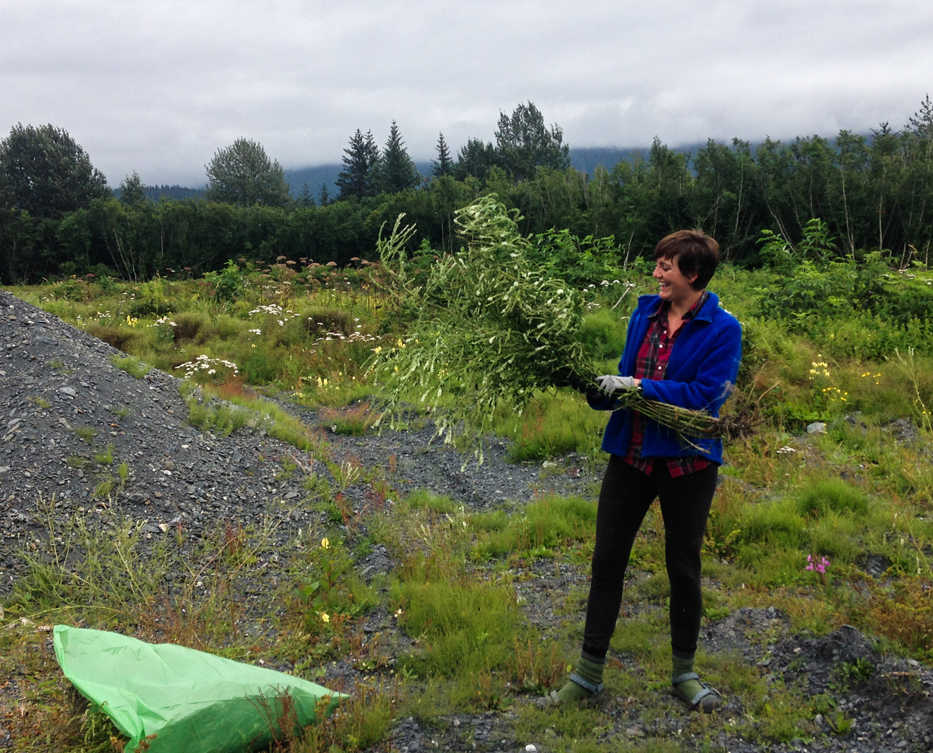Sunny, warm days and only a few mosquitos trying to suck my blood lifted my spirits last summer in my uncertain quest to find (and hopefully eradicate) reed canary grass, white sweetclover and bird vetch. Based on some bad experiences in the Lower 48, these three invasive weeds have great potential to do great harm on the Kenai Peninsula.
Within a few decades of mistakenly planting reed canary grass in the Pacific Northwest for soil stabilization and forage, this species spread into wetlands where it disrupted stream flow and devastated salmon habitat in Oregon and Washington to a point of no return. Bird vetch and white sweetclover were similarly planted for forage, but these Old World species soon out-competed almost every native plant. Vetch can change soil nitrogen and completely replace land cover as its vine-like growth smothers native flora. White sweetclover can alter the landscape as well by changing sedimentation rates in streams with gravel bars.
These threats led me to devote last summer working for the Homer Soil and Water Conservation District, where Matt Steffy coordinates the interagency partners of the Kenai Peninsula Cooperative Weed Management Area (www.kenaiweeds.org). “It’s pretty unique to have so many different entities working together to accomplish so many interconnected goals” Steffy told me. It is this fellowship that sets the stage for great success in the war on weeds on the Kenai Peninsula.
A major player in the partnership is Chugach National Forest, for they are the frontline of the Kenai Peninsula, seeing invasives first as they spread down the Seward Highway from Anchorage. “We found that most of our invasive plant populations are in areas with human-caused disturbance,” Betty Charnon, a Forest Service ecologist told me. That human footprint is true for the Kenai National Wildlife Refuge as well, where most of our invasives occur along the Swanson, Skilak and Funny River roads. Similarly, Christina Kriedman, an environmental specialist with Kenai Fjords National Park, explains “Herman Leirer Road, the only road in the park, is the primary vector that brings invasive plants into the Exit Glacier area where we spend most of our time controlling invasive plants.”
So, working closely with my sidekick, Kelsey Haas, we traveled miles and miles of Kenai Peninsula Borough and Alaska Department of Transportation right-of-ways last summer. The mission of our two-person strike team was survey and begin managing infestations of these three species outside of the large federal land management units. Invasives know no boundaries, disrespectful of lines drawn on jurisdictional maps.
We visited 54 sites in Seward that had previously reported infestations of white sweetclover, to which after five years of active management, only 11 sites remain infested. If each site is a battlefield, then we’ve won 80 percent of the time! Outside of Seward, we found white sweetclover to be practically non-existent on the Kenai Peninsula except around the Portage-Whittier tunnel. This area is especially important as Whittier is the gateway to the pristine Prince William Sound.
We found bird vetch growing in 30 locations that totaled 50 acres on the Kenai Peninsula. In Homer, vetch occurs only at the corner of Skyline and Katie Jean, and at the Islands and Oceans Visitor Center. Further up the Sterling Highway, we found a patch at Stariski Creek, four infestations in Soldotna, two in the city of Kenai, and one site in Nikiski. With such small point locations, it’s easy to formulate a game plan to eradicate bird vetch from our communities.
Eradication of bird vetch will be trickier in Seward (15 infestations totaling 10 acres) and Portage (21 acres), where relatively large infestations plague the landscape. However, with cooperation and diligence we have a very real chance of eradicating bird vetch completely from the Kenai Peninsula.
Unfortunately, reed canary grass is here to stay. Although it only occurs in 30 of 127 watersheds on the Kenai Peninsula, reed canary grass is too dispersed in those infested streams to seriously entertain the idea of eradicating it. So, using a strategy of containment rather than eradication, we focus on keeping reed canary grass out of the almost 100 watersheds that are pristine by treating connecting right-of-ways and other vectors like airstrips. And when a new infestation takes root, we strike it down and take it out completely before it spreads.
The time to act is NOW. Permits and preparations are already underway to apply herbicide to infestations found last summer. The interagency collaboration is more strategic than ever, allowing us to nip future infestations in the bud faster and more efficiently. With so little of the Kenai Peninsula occupied by bird vetch and white sweetclover, the opportunity is ours to make them go away.
Please contact Matt Steffy (907-235-8177) if you wish to report an infestation that we missed last summer. For more opportunity to contribute to the war on invasive plants, please download the free app “Alaska Weeds ID.”
Jen Peura is a seasonal biotech at the Kenai National Wildlife Refuge. Find more information at http://www.fws.gov/refuge/kenai/ or http://www.facebook.com/kenainationalwildliferefuge.

